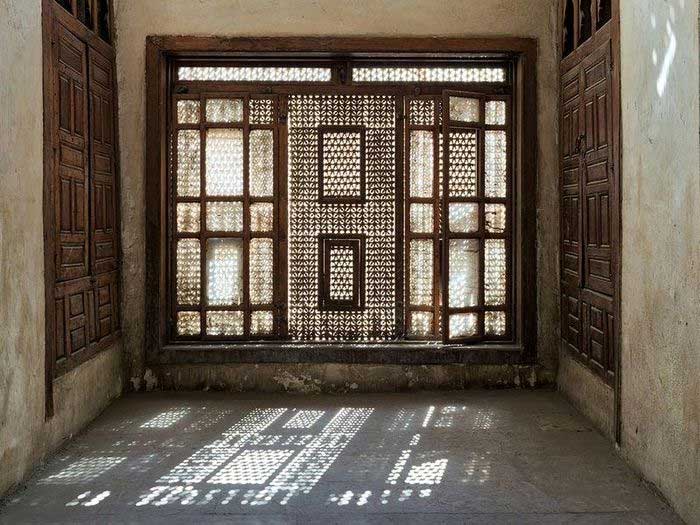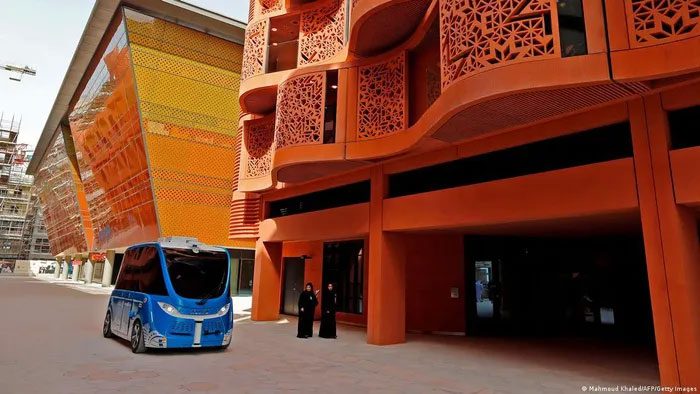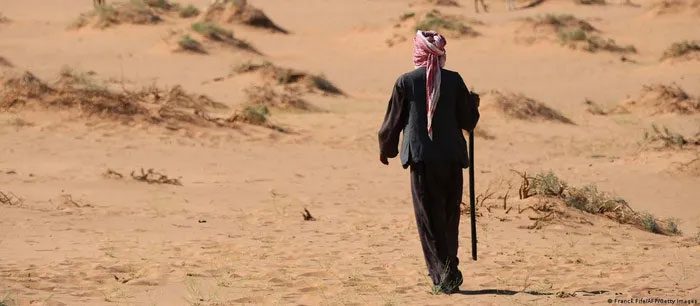Experts believe that the Middle East has “a wealth of experience” for other regions to learn from regarding survival in extreme heat.
Long-standing Experience

In buildings, Mashrabiya wooden screens are used to shield large windows from the sun. (Illustration: gulfnews.com)
According to DW (Germany), several optimal methods to cope with high temperatures have been present in the Middle East. Professor Sylvia Bergh from Erasmus University Rotterdam (Netherlands) pointed out that the people of the Middle East are accustomed to high temperatures, leading them to prefer living in cooler homes.
Ms. Bergh noted that the centuries-old traditions of the Middle East have adapted to deal with water scarcity and hot temperatures, resulting in valuable knowledge. She mentioned several adaptive adjustments in the Middle East, such as “windcatcher” towers that direct cool air into living spaces, using screens instead of walls, and carved Mashrabiya panels made of wood or stone with Islamic patterns. These screens are placed in front of large windows, blocking and diffusing sunlight, allowing fresh air to flow into living spaces while providing privacy.
Additionally, some new construction projects in the Middle East draw inspiration from traditional architecture to maximize passive shading and air circulation in hot, dry, and windy desert conditions. An example is the Masdar City project in Abu Dhabi (United Arab Emirates), where short (under 70 meters) and narrow streets are shielded by buildings, resulting in lower street temperatures—sometimes only 20 degrees Celsius, while just a few meters away, desert temperatures can reach up to 35 degrees Celsius.

In Masdar City, Abu Dhabi, streets are designed to take advantage of shade and wind. Photo: AFP
Journalist Kholoud al-Amiry in Baghdad (Iraq) shared that when the thermometer shows a rise to 50 degrees Celsius, local residents often take breaks and are advised to stay indoors. She noted that people receive information via television or social media platforms like Facebook. They are also advised to place bowls of water under trees for birds and other animals during hot weather. Kholoud al-Amiry shared that local authorities also inform residents about overcrowding in hospitals during heatwaves or sandstorms.
However, there are significant differences in how Middle Eastern countries adapt to high temperatures. Air conditioning is an example of how wealthy countries like those in the Gulf protect vulnerable populations from the heat. In countries with more modest economies, local people often cannot afford air conditioning, making it not a common solution.
The Middle East Also Faces Risks from Extreme Temperatures

The average high temperature in summer in Saudi Arabia is 38 degrees Celsius. (Photo: AFP).
In May, a study published in the journal Nature Sustainability projected the impacts of extreme temperatures on the world over the next 50 years if global temperatures rise by 1.5 degrees Celsius. Extreme temperatures are recorded when the average annual temperature hovers around 29 degrees Celsius. According to this study, by 2050, most people in the Middle East will face extreme temperatures.
Another study published in the medical journal The Lancet in April focused on the number of heat-related deaths in the Middle East and North Africa if the Earth continues to warm. The study predicts that heat-related mortality rates in these two regions will rise from the current average of 2 per 100,000 people to 123 per 100,000 people in the last two decades of the century.
The research published in The Lancet also emphasized that demographic factors and the increasing migration of people to cities in the Middle East will affect the severity of extreme temperatures on local populations. By 2050, it is expected that nearly 70% of the population will live in major cities, and by 2100, the elderly in the Middle East will outnumber the youth.
Authors of the study at the London School of Hygiene & Tropical Medicine and the Cyprus Institute noted: “Older age and dense population are key risk factors for heat-related illness and mortality.” The elderly are at risk physically, while cities often experience higher temperatures due to the “urban heat island” effect. According to DW, cities can be 2-9 degrees Celsius warmer than surrounding rural areas.
Ms. Eleni Myrivili at UN Habitat—the United Nations Human Settlements Programme—emphasized to DW that to effectively respond to threats from extreme temperatures, governments need clear action plans to increase awareness, preparedness, and resilience.
Action plans can help residents cope with high temperatures. These may include “cooling centers” operated by the government where people can go to escape the heat and hydrate, or preparatory measures such as educational campaigns on how to stay cool during heat spikes or planting more trees in urban areas.


















































